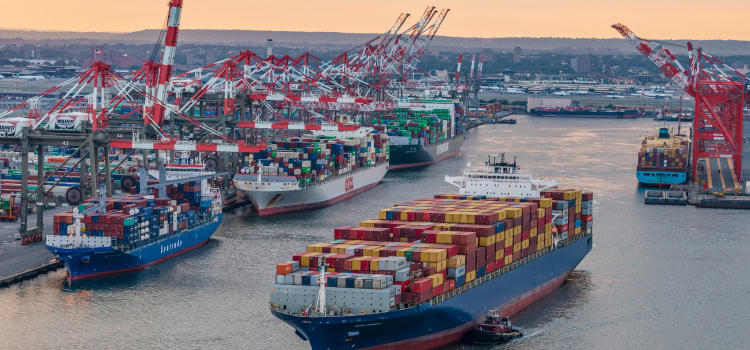Companies Prepare for Fallout from East Coast Port Strike

Disruptive strike actions have begun at major U.S. ports on the East and Gulf Coasts such as New York-New Jersey, Savannah, and Houston, exposing ports across the United States to work stoppages, shipping and cargo processing delays, and worsening backlogs. Three main scenarios could unfold.
Disruptive strike actions have begun at major U.S. ports on the East and Gulf Coasts such as New York-New Jersey, Savannah, and Houston, exposing ports across the United States to work stoppages, shipping and cargo processing delays, and worsening backlogs. Three main scenarios could unfold.
The clock has run out on an agreement that could have prevented worker strikes at East Coast and Gulf Coast ports and will leave shippers and West Coast ports adjusting to the fallout.
A summer-long standoff between the International Longshoremen’s Association (ILA) and the U.S. Maritime Alliance (USMX) yielded no progress in collective bargaining, which has led to a work stoppage at ports such as New York-New Jersey, Savannah, Houston, and points in between after the current contract expired on Sept. 30.
President Joe Biden has said he will not invoke Taft-Hartley Act provisions to intervene in the strike despite the economic impact a strike would have shortly before the presidential election. Other potential means of mediating the dispute, such as the intervention by Labor Secretary Julie Su during the 2022-2023 West Coast port strikes, have so far not emerged.
The extent of disruptions resulting from a strike is uncertain, but there are currently three possible outcomes.
No Strike Traffic at ports will remain unchanged, though there may be some minor disruptions.
Work-to-Rule. Workers doing the bare minimum required by their contract will slow down operations and could lead to sporadic disruptions and unexpected walkouts. The resulting longer wait queues could prompt shippers to choose West Coast alternatives.
Full-Scale Strike. A complete work stoppage would strangle shipping on the East and Gulf coasts, with heavy congestion, longer vessel queues and container backlogs, and knock-on congestion at West Coast and Canadian ports as shippers opt for alternate routes.
Labor Dispute and Strike Impact
The labor dispute between the International Longshoremen’s Association (ILA) and the United States Maritime Alliance (USMX) has escalated into a full-blown strike, significantly impacting the East and Gulf Coasts. Starting on October 1, 2024, the strike involves 45,000 dockworkers across 36 container ports from Texas to Maine. The ILA is pushing for higher wages, improved benefits, and a ban on automation, while the USMX has countered with a nearly 50% wage increase over six years.
This strike is projected to cost the U.S. economy between $4.5 billion and $7.5 billion per week, according to Oxford Economics. The repercussions are being felt across various sectors, including manufacturing, retail, and agriculture, with delays and cancellations of shipments already occurring and expected to worsen.
Despite the strike, the ILA has committed to handling all military cargo and passenger cruise vessels, ensuring that these critical operations continue. However, the broader supply chain is expected to suffer, leading to shortages and price hikes. The U.S. Chamber of Commerce has called on President Joe Biden to intervene, but he has stated he will not use his Taft-Hartley Act powers to force union workers back to work.
Customers Can Anticipate the Impact on Supply Chain
Shipping customers need to prepare for the impact of a strike and any related developments, as they may need to divert shipments or, in some cases, make a temporary switch to air freight. Terminal operators are also affected by the strike and are working to manage the disruptions. Tools are available that can help make their response more seamless.
An automated risk management tool that issues alerts would be helpful in tracking the labor negotiations, or any other new developments, such as if West Coast workers walked out in solidarity—though no such move is currently planned. The tool could also make customers aware of any delays at West Coast ports caused by increased traffic. A real-time shipment visibility tool can help companies visualize a strike’s impact throughout their supply chains, help them predict delivery times, choose the most viable options for maintaining delivery schedules and issue alerts to their own customers.
With a strike looming, companies that rely on maritime shipments will most likely experience significant disruptions. But those who are best prepared can limit that impact and better weather the coming storm.
Daily count of waiting cargo vessels outside major North American ports, 2024 (source: Everstream Analytics)
Alternative Shipping Routes and Solutions
As the strike continues to disrupt the East and Gulf Coasts, companies are scrambling to find alternative shipping routes and solutions. Many are diverting their cargo to West Coast ports, which remain unaffected by the strike. However, this shift is likely to lead to congestion and delays at these ports, as they may struggle to handle the increased volume.
Some companies are also exploring the use of ports in Canada and Mexico as alternatives. While these ports offer potential relief, they may lack the infrastructure and capacity of the East and Gulf Coast ports, posing additional challenges.
In addition to rerouting shipments, companies are considering alternative modes of transportation such as air freight and rail. Although these options can help mitigate the impact, they come with higher costs and may not accommodate the same volume of cargo as maritime routes.
The strike underscores the importance of having a diversified supply chain and robust contingency plans. Companies that have already diversified their supply chains and prepared for disruptions are better positioned to navigate the current challenges.
Overall, the strike is causing significant disruptions on the East and Gulf Coasts, prompting companies to seek alternative shipping routes and solutions to maintain their supply chains.
